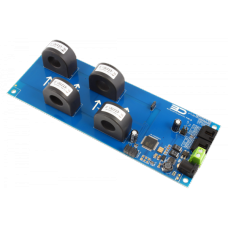4-Channel On-Board 97% Accuracy 70-Amp AC Current Monitor with I2C Interface
Current monitoring of your AC power loads is now possible using cross-platform I2C communications, making current monitoring possible for your Raspberry Pi, BeagleBone, Arduino, or any other computing platform that support I2C. Monitor current and keep track of your power consumption using your favorite computing platform. This controller has four 70-Amp current monitoring channels, precision tuned to monitor the current flow through the on-board current sensor with a 3% maximum error rate (Tested up to 70 Amps). This controller is available for purchase in 10, 20, 30, 50, or 70-Amp input ranges. We suggest choosing a amperage range that properly suits the load you intend to monitor for best accuracy and resolution.
To use this device, simply run an AC power wire, up to 10mm in size, through the center of the sensors. The on-board custom designed CPU will do the rest using I2C communications. This controller includes an I2C expansion port, allowing expansion for more current monitoring inputs or other types of I2C sensors and devices. Four on-board address jumpers allow expansion of up to 16 current monitoring devices through the I2C expansion port. Mix and match current monitoring controllers of any size to meet your specific application requirements.
Software developers can take advantage of our ControlEverythingCom GitHub repository for current monitoring and programming samples. This device only requires a 12VDC power supply for operation, which may be plugged into the controller using a 2.1mm center positive barrel connector or on-board terminal block for direct wired power supplies.
What is the NCD I2C Interface?
NCD is the creator of plug and play modular hardware using the NCD I2C Interface connector standard. NCD I2C devices allow you to chain together several devices on the I2C bus, and communicate to each device individually at high speed (subject to the limitations of I2C). The NCD I2C Interface uses a standard 4-Pin I2C Input and I2C Output connector. NCD I2C devices communicate 5V I2C data and provides 5V DC power through this connector. NCD I2C devices use standard I2C communications for all data transport, which is supported by nearly every microcontroller in production today. The NCD I2C Interface is strictly a 5V standard, which is ideal for transport across longer cables. NCD I2C devices always include a 6″ (152mm) 4-conductor I2C cable. NCD I2C Mini Modules always include a 3″ (76mm) 4-conductor I2C cable. Cables and connectors are available separately for designers who would like to include their own NCD I2C Interface into their designs.
Plug and Play Connectivity
NCD I2C devices will plug in to any available NCD I2C Output. This includes just about everything we make in the NCD IoT Category, including all NCD IoT devices. We also manufacture a wide range of I2C adapters that make it easy to plug NCD I2C Devices directly into most computing platforms. The NCD I2C Interface adapters are available for Arduino, Banana Pi, BeagleBone, Bluz, C.H.I.P., ESP8266, Onion Omega, Particle Photon and Electron, PyCom, Raspberry Pi, 2, 3, and Zero, and Windows. We are always working to add new platform support for NCD I2C devices. NCD I2C Interface devices are compatible with just about everything in the microcontroller industry.
Unlimited I2C Expansion
Based on our plug-and-play I2C interface standard, all NCD I2C devices are equipped with a I2C output port, making it easy to expand to a wide variety of sensors, current monitors, relay controllers, PWM controllers, and much more! We are always designing new expansions for our modular plug-and-play I2C framework. We are dedicated to building a product line of interconnected devices to simplify all forms of automation. Re-use or upgrade your hardware in seconds by selecting the modules that best fit your needs, and chaining them together using the included I2C expansion cables!
Powering NCD I2C Interface Devices
Some NCD I2C devices require a external power supply, others may be powered through the 4-Pin I2C bus connector at 5VDC, and other devices are jumper selectable between external and I2C bus power. All I2C mini modules are powered through the 5V I2C bus connector, greatly simplifying connectivity.
Features
- I2C Current Monitoring Controller
- Ideal for use with PC using Windows 8/10 via USB
- Compatible with Arduino, Raspberry Pi, Onion, PyCom
- 4-Channel Input with 10, 20, 30, 50 or 70-Amp Input Range
- Solid Core Current Sensors with 3% Max Error Rate
- Cross-Platform Compatible I2C Communications
- On-Board I2C Expansion Port
- Expandable to 16 Devices per I2C Port
- FREE I2C Cable Included
- 0x2A I2C Start Address
Enter the code in the box below:





